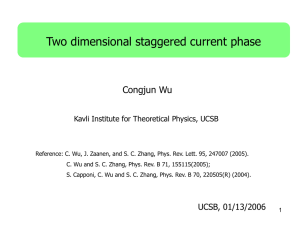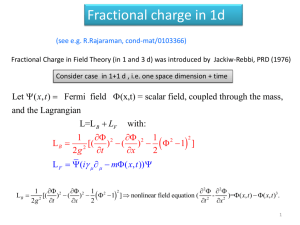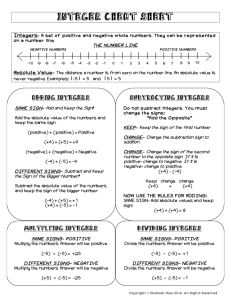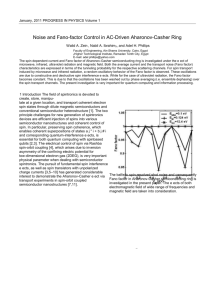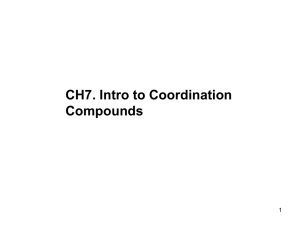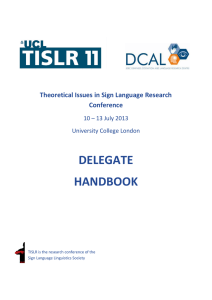T-invariant Decomposition and the Sign Problem in Quantum Monte Carlo Simulations
advertisement
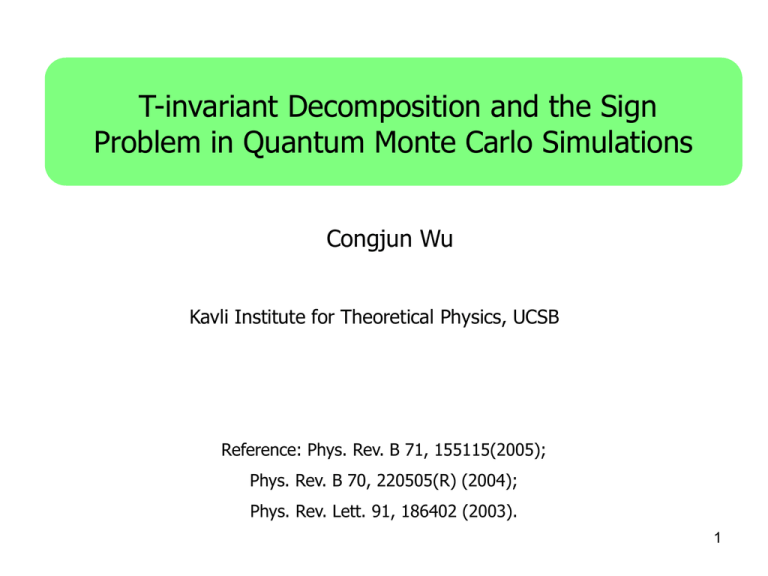
T-invariant Decomposition and the Sign
Problem in Quantum Monte Carlo Simulations
Congjun Wu
Kavli Institute for Theoretical Physics, UCSB
Reference: Phys. Rev. B 71, 155115(2005);
Phys. Rev. B 70, 220505(R) (2004);
Phys. Rev. Lett. 91, 186402 (2003).
1
Collaborators
• S. Capponi, Université Paul Sabatier, Toulouse, France.
• S. C. Zhang, Stanford.
Many thanks to D. Ceperley, D. Scalapino, J. Zaanen for helpful
discussions.
2
Overview of numeric methods
• Quantum many-body problems are hard to solve
analytically because Hilbert spaces grow exponentially
with sample size. No systematic, non-perturbative
methods are available at high dimensions.
• Exact diagonalization: up to very small sample
size.
• Density matrix renormalization group: restricted
one dimensional systems.
• Quantum Monte-Carlo (QMC) is the only scalable
method with sufficient accuracy at D 2 .
3
Outline
• A sufficient condition for the absence of the
sign problem.
• The conclusive demonstration of a 2D staggered ground
state current phase in a bilayer model.
• Physics of the staggered current state.
• Applications in spin 3/2 Hubbard model.
4
Classical Monte-Carlo: Ising model
• Probability distribution:
H J iz
w({ i }) exp[ H ({ i })] / Z
z
j
ij
• Observables: magnetization and susceptibility.
M
1
N
w{ }( i )
{ }
i
1
N2
w{ }( i )
{ }
2
i
• Metropolis sampling:
1. Start from a configuration {s} with probability w({s}).
Get a trial configuration by flipping a spin.
2. Calculate acceptance ratio: r w({ trial}) / w({ }) .
3. If r>1, accept it; If r<1, accept it wit the probability of r.
5
Fermionic systems
• Strongly correlated fermionic systems: electrons in
solids, cold atoms, nuclear physics, lattice gauge
theory, QCD.
In particular, high Tc superconductivity: 2D Hubbard
model in a square lattice.
H t {ci c j h.c} nˆi U (nˆi 12 )( nˆi 12 )
ij
i
i
• How to sample fermionic fields, which satisfy the
anti-commutation relation?
[c j , ci ] ij
6
Auxiliary Field QMC
Blankenbecler, Scalapino, and Sugar. PRD 24, 2278 (1981)
• Using path integral formalism, fermions are represented as
Grassmann variables.
• Transform Grassmann variables into probability.
Probability:
positive number
Auxiliary field
QMC
Fermions:
Grassmann number
• Decouple interaction terms using Hubbard-Stratonovich
(H-S) bosonic fields.
• Integrate out fermions and the resulting fermion
functional determinants work as statistical weights.
7
The Negative U Hubbard model(I)
H t {ci c j h.c} nˆi | U | (nˆi 12 )( nˆi 12 )
ij
i
i
• H-S decoupling in the density channel: 4-fermion
interaction quadratic terms.
H I | U | (ci ci ci ci )ni
i
• H-S decoupling becomes exact by integrating over
fluctuations.
Z Dc Dc exp d ci
0
DnDc Dc exp d
{
0
i
ci H K H I
|U |
(ni ( ) 1) 2 ci
2
}
ci H K H I ( )
8
The Negative U Hubbard model(II)
• Integrating out fermions: det(I+B) as statistical weight.
Z dn exp{
|U |
2
2
d
(
n
(
)
1
)
det( I B)}
i
0
i
• B is the imaginary time evolution operator.
B exp{ d H K H I ( )}
0
H I ( ) | U | ci, ( )ci , ( )n(i, )
i
• Factorization of det(I+B): no sign problem.
det( I B) det( I B ) det( I B ) | det( I B ) |2 0
9
The Positive U Hubbard model
H t {ci c j h.c} nˆi U (nˆi 12 )( nˆi 12 )
ij
i
i
• H-S decoupling in the spin channel.
Z dn exp{ U2 d szi2 ( ) det( I B ) det( I B )}
0
i
B exp{ d H K H I ( )}
0
H I ( ) U c i ( )c i c i ( )c i ( ) szi ( )
i
• Half-filling in a bipartite lattice (=0). Particle-hole
i
transformation to spin down electron ci () ci .
det( I B ) const det( I B ) no sign problem.
10
Antiferromagnetic Long Range Order at Half-filling
AF structure factor S(p,p) as a function of =1/T for various
lattice sizes. (White, Scalapino, et al, PRB 40, 506 (1989).
11
Pairing correlation at 1/8 filling
small size results:4*4 lattice
Pairing susceptibility in
various channels.
Solid symbols are full
pairing correlations.
Open symbols are RPA
results.
(White, Scalapino, et al, PRB 39, 839 (1989).
12
The sign (phase) problem!!!
• Generally, the fermion functional determinants are not
positive definite. Sampling with the absolute value of
fermion functional determinants.
O sign O
/
sign
• Huge cancellation in the average of signs.
• Statistical errors scale exponentially with the
inverse of temperatures and the size of samples.
• Finite size scaling and low temperature physics
inaccessible.
13
A general criterion: symmetry principle
• Need a general criterion independent of factorizibility
of fermion determinants.
The T (time-reversal) invariant decomposition.
• Applicable in a wide class of multi-band and high
models at any doping level and lattice geometry.
The bi-layer spin ½ models : staggered current phase
Reference: CW and S. C. Zhang cond-mat/0407272, to appear in Phys. Rev. B;
C. Capponi, CW, and S. C. Zhang, Phys. Rev. B 70, 220505(R) (2004).
14
Digression: Time reversal symmetry
• Kramers’ degeneracy in fermionic systems.
T 2 1,
T H T 1 H
|f>, T|f> are degenerate Kramer doublets <f|T|f>=0.
• Effects in condensed matter physics:
Anderson theorem for superconductivity;
Weak localization in disordered systems etc.
15
T-invariant decomposition
CW and S. C. Zhang, to appear in PRB, cond-mat/0407272; E. Koonin et. al., Phys. Rep. 278 1, (1997)
• Theorem: If there exists an anti-unitary transformation T
T 2 1, TH K T 1 H K , TH I T 1 H I
for any H-S field configuration, then
det( I B) 0
Generalized Kramer’s degeneracy
• I+B may not be Hermitian, and even not be diagonalizable.
• Eigenvalues of I+B appear in complex conjugate pairs (l,l*.
• If l is real, then it is doubly degenerate.
det( I B) (l1 l1* )(l2 l*2 ) (ln l*n ) 0
• T may not be the physical time reversal operator.
16
Distribution of eigenvalues
17
The sign problem in spin 1/2 Hubbard model
TnT
1
1
n, TST S
• U<0: H-S decoupling in the density channel.
T-invariant decomposition absence of the sign problem
• U>0: H-S decoupling in the spin channel.
Generally speaking, the sign problem appears.
• The factorizibility of fermion determinants is not required.
Validity at any doping level and lattice geometry.
Application in multi-band, high spin models.
18
Outline
• A sufficient condition for the absence of the sign
problem.
• The conclusive demonstration of a 2D staggered
ground state current phase in a bilayer model.
• Physics of the staggered current state.
• Application in spin 3/2 Hubbard model.
19
The ground state staggered current phase
• D-density wave: mechanism of the pseudogap in high Tc
superconductivity?
Chakravarty, et. al., PRB 63, 94503 (2000);
Affleck and Marston, PRB 37, 3774 (1988);
Lee and Wen, PRL 76, 503 (1996);
• Staggered current phase in two-leg ladder systems.
Bosonization+renormalization group:
Lin, Balents and Fisher, PRB 58, (1998);
Fjarestad and Marston, PRB 65, (2002);
CW, Liu and Fradkin, PRB 68, (2003).
Numerical method: Density matrix renormalization group:
Marston et. al., PRL 89, 56404, (2002); U. Schollwöck et al., PRL 90, 186401, (2003).
20
Application: staggered current phase in a bilayer model
• Conclusive results: Fermionic
QMC simulations without the sign
problem.
• 2D staggered currents pattern:
alternating sources and drains;
curl free v.s. source free
• T=Time reversal operation
*flipping two layers
top view
d-density wave
S. Capponi, C. Wu and S. C. Zhang, PRB 70,
220505 (R) (2004).
21
The bi-layer Scalapino-Zhang-Hanke Model
D.
Scalapino, S. C. Zhang, and W. Hanke, PRB 58, 443 (1998)
c
U
t //
t
J
V
d
H t // {ci c j d i d j h.c} t {ci d j h.c} n(i)
ij
i
i
J Sic Sid U (ni ,,c 12 )( ni ,,c 12 ) (c d ) V (ni ,c 1)(ni ,d 1)
ij
i
i
• U, V, J are interactions within the rung.
• No inter-rung interaction.
22
T-invariant decoupling (Time-reversal*flip two layers)
• T-invariant operators: total density, total density;
bond AF, bond current.
c
nbond (i) 12 (di ci ci di )
n(i) (ci ci d i d i )
1
nAF (i) 2 (ci ci di di ) ncurt (i) 2i (ci di di ci )
d
• When g, g’, gc>0, T-invariant H-S decoupling
absence of the sign problem.
H SZH t // {ci c j d i d j h.c} t nbond (i) n(i)
ij
i
2
2
2
g {nbond
(i) ncurt
(i )} g n AF
(i) g c (n(i) 2) 2
i
i
i
i
3
J
3
4. g U V J , 4 g U V , 4 g c U 3V J
4
4
4
23
Fermionic auxiliary field QMC results at T=0K
• The equal time staggered
current-current correlations
1
J (r ) 2 ncurr (ri )ncurr (ri r )
L i
iQr
J (Q) e J (r ) Q (p , p )
r
• Finite scaling of J(Q)/L2
v.s. 1/L.
• True long range order:
Ising-like order
t // 1, t 0.1, U 0, V 0.5, J 2.0
S. Capponi, CW and S. C. Zhang, PRB 70, 220505 (R) (2004).
24
Outline
• A sufficient condition for the absence of the sign
problem.
• The conclusive demonstration of a 2D staggered ground
state current phase in a bilayer model.
• Physics of the staggered current state.
• Application in spin 3/2 Hubbard model.
25
Strong coupling analysis at half-filling
• The largest energy scale J>>U,V.
• Project out the three rung
triplet states.
+
• Low energy singlet Hilbert space:
doubly occupied states, rung singlet state.
=
E: U
-
V 34 J
U
26
Pseudospin SU(2) algebra
• The pseudospin SU(2) algebra v.s. the spin SU(2) algebra.
c
d
ncurt (i) 2i (ci di di ci )
rung current
nbd (i) 12 (di ci ci di )
bond strength
Q(i) 12 (ci ci di di )
cdw
• Pseudospin-1 representation.
Q : 1;
0,
• Rung current states
1
| up , down
a ;
E:
U
b
V 34 J
c
U
1
2
i
2
27
Pseudospin-1 AF Heisenberg Hamiltonian
• t// induces pseudospin exchange.
t //
t //
H ex J pseudo {ncurt (i ) ncurt ( j )
ij
nbd (i )nbd ( j ) Q (i )Q ( j )}
• Anisotropic terms break SU(2) down to Z2 .
c
t
d
E
t : uniform external field
E : on - site anisotropy
1
H 2t nbd (i) E (Q 2 (i) )
2
i
E U (V 34 J )
28
Competing phases
• Neel order phases and rung singlet phases.
staggered current
CDW
staggered bond order
rung singlet
29
Competing phases
• 2D spin-1 AF Heisenberg model has long range Neel order.
t
E 0
favors the easy plane of staggered current and CDW.
favors the easy plane of staggered current and bond order.
SU(2)Z2
the easy axis of the staggered current
• Subtle conditions for the staggered current phase.
t is too large polarized pseudospin along rung bond strength
E is too large rung singlet state
t 2z J p
( z 4), 0 E zJ p
30
Fermionic auxiliary field QMC results at T=0K
• The equal time staggered
current-current correlations
1
J (r ) 2 ncurr (ri )ncurr (ri r )
L i
iQr
J (Q) e J (r ) Q (p , p )
r
• Finite scaling of J(Q)/L2
v.s. 1/L.
• True long range order:
Ising-like order
t // 1, t 0.1, U 0, V 0.5, J 2.0
S. Capponi, CW and S. C. Zhang, PRB 70, 220505 (R) (2004).
31
Disappearance of the staggered current phase
i) increase t
ii) increase
E U (V 34 J )
iii) increase doping
32
Outline
• A sufficient condition for the absence of the sign
problem.
• The conclusive demonstration of a 2D staggered ground
state current phase in a bilayer model.
• Physics of the staggered current state.
• Application in spin 3/2 Hubbard model.
33
The spin 3/2 Hubbard model
H
t{c c
i,
j ,
3 1
ij , ,
2 2
h.c.} ci, ci ,
i
U 0 P00 (i ) P00 (i ) U 2
i
P
(
r
)
P
(
r
)
2m
2m
i , m 2 , 1, 0
• The generic Hamiltonian with spin SU(2) symmetry.
• F=0 (singlet), 2(quintet); m=-F,-F+1,…F.
P (r ) 32 32 ; Fm |
Fm
3 3
2 2
; (r ) (r )
• Optical lattices with ultra-old atoms such as
132Cs, 9Be, 135Ba, 137Ba.
34
T-invariant decoupling in spin 3/2 model
• T-invariant operators: density and spin nematics operators.
a
n(i) ci, ci , , na (i) ci,
ci ,
• Five spin-nematics matrices = Dirac G matrices:
a ija{Si S j S j Si } (a 1 5) (i, j 1 3) { a , b } 2 ab
• Explicit SO(5) symmetric form:
Wu, Hu and Zhang, PRL91, 186402 (2003).
V, W>0 absence of the sign problem.
H
t
{
c
c
h
.
c
.}
c
i, j ,
i, ci,
ij ,
V
3U 0 5U 2
,
16
i
W
U2 U0
4
2
2
{
V
(
n
(
i
)
2
)
Wn
a (i )}
i ,1 a 5
35
Application in spin 3/2 system
36
Summary
• The “time-reversal” invariant decomposition criterion
for the absence of the sign problem.
• Applications:
The bilayer spin 1/2 modelstaggered current phase.
• Other applications:
High spin Hubbard model;
Model with bond interactions: staggered spin flux phase
.
37
